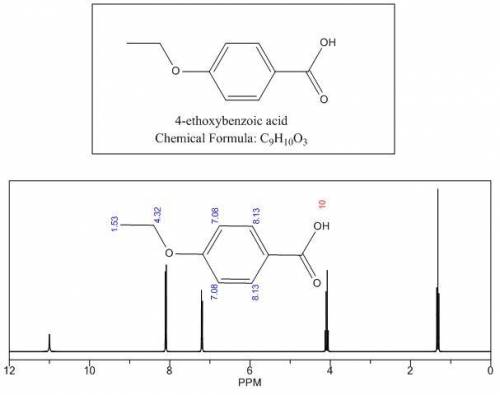
Chemistry, 10.03.2020 01:34 haleyscales825
Provide a structure for the following compound: C9H10O3; IR: 2400–3200, 1700, 1630 cm–1; 1H NMR: δ 1.53 (3H, t, J = 8 Hz); δ 4.32 (2H, q, J = 8 Hz); δ 7.08, δ 8.13 (4H, pair of leaning doublets, J = 10 Hz); δ 10 (1H, broad, disappears with D2O shake)

Answers: 1


Another question on Chemistry

Chemistry, 21.06.2019 13:00
What is common about these molecules? a.their atoms are held together by covalent bonds. b.they are all made up of the same two atoms. c.their atoms are held together by ionic bonds. d.they are all made up of oxygen atoms only.
Answers: 3

Chemistry, 22.06.2019 04:30
Use the periodic table to determine the electron configuration of dysprosium (dy) and americium (am) in noble-gas notation.
Answers: 1

Chemistry, 22.06.2019 05:00
Use the table to identify the phase and phase changes of the elements under the given conditions. write the name of the substance, phase, or phase change
Answers: 3

Chemistry, 22.06.2019 11:40
Effect of rotenone and antimycin a on electron transfer rotenone, a toxic natural product from plants, strongly inhibits nadh dehydrogenase of insect and fish mitochondria. antimycin a, a toxic antibiotic, strongly inhibits the oxidation of ubiquinol. (a) explain why rotenone ingestion is lethal to some insect and fish species. (b) explain why antimycin a is a poison. (c) given that rotenone and antimycin a are equally effective in blocking their respective sites in the electron-transfer chain, which would be a more potent poison? explain.
Answers: 3
You know the right answer?
Provide a structure for the following compound: C9H10O3; IR: 2400–3200, 1700, 1630 cm–1; 1H NMR: δ 1...
Questions



Mathematics, 13.11.2020 03:10

Mathematics, 13.11.2020 03:10


Mathematics, 13.11.2020 03:10


English, 13.11.2020 03:10


English, 13.11.2020 03:10





Mathematics, 13.11.2020 03:10


Mathematics, 13.11.2020 03:10



Mathematics, 13.11.2020 03:10




